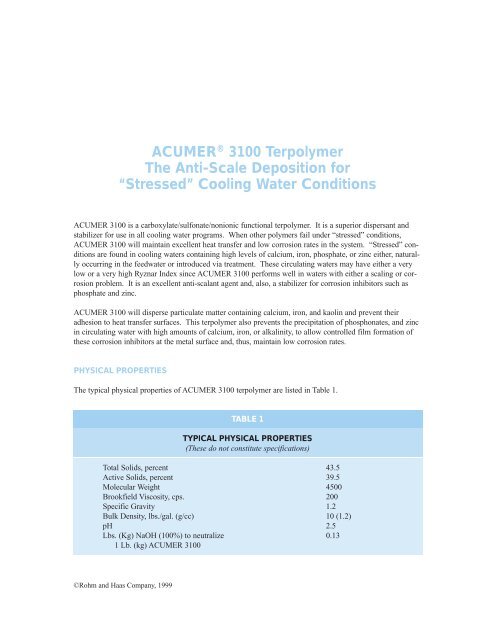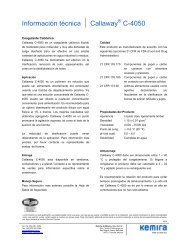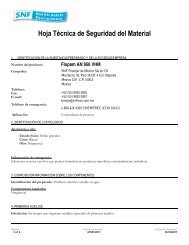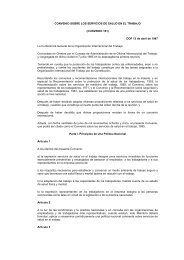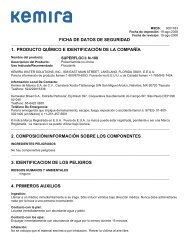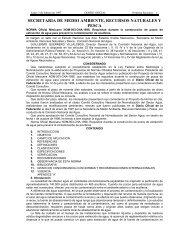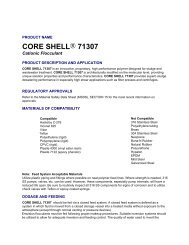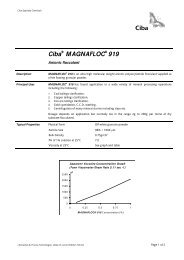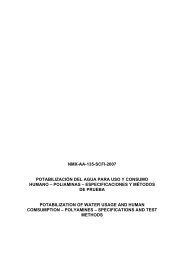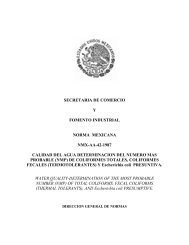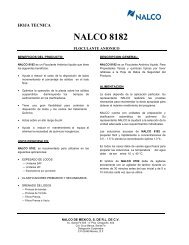ACUMER 3100 Terpolymer The Anti-Scale Deposition for ...
ACUMER 3100 Terpolymer The Anti-Scale Deposition for ...
ACUMER 3100 Terpolymer The Anti-Scale Deposition for ...
Create successful ePaper yourself
Turn your PDF publications into a flip-book with our unique Google optimized e-Paper software.
<strong>ACUMER</strong> ® <strong>3100</strong> <strong>Terpolymer</strong><br />
<strong>The</strong> <strong>Anti</strong>-<strong>Scale</strong> <strong>Deposition</strong> <strong>for</strong><br />
“Stressed” Cooling Water Conditions<br />
<strong>ACUMER</strong> <strong>3100</strong> is a carboxylate/sulfonate/nonionic functional terpolymer. It is a superior dispersant and<br />
stabilizer <strong>for</strong> use in all cooling water programs. When other polymers fail under “stressed” conditions,<br />
<strong>ACUMER</strong> <strong>3100</strong> will maintain excellent heat transfer and low corrosion rates in the system. “Stressed” conditions<br />
are found in cooling waters containing high levels of calcium, iron, phosphate, or zinc either, naturally<br />
occurring in the feedwater or introduced via treatment. <strong>The</strong>se circulating waters may have either a very<br />
low or a very high Ryznar Index since <strong>ACUMER</strong> <strong>3100</strong> per<strong>for</strong>ms well in waters with either a scaling or corrosion<br />
problem. It is an excellent anti-scalant agent and, also, a stabilizer <strong>for</strong> corrosion inhibitors such as<br />
phosphate and zinc.<br />
<strong>ACUMER</strong> <strong>3100</strong> will disperse particulate matter containing calcium, iron, and kaolin and prevent their<br />
adhesion to heat transfer surfaces. This terpolymer also prevents the precipitation of phosphonates, and zinc<br />
in circulating water with high amounts of calcium, iron, or alkalinity, to allow controlled film <strong>for</strong>mation of<br />
these corrosion inhibitors at the metal surface and, thus, maintain low corrosion rates.<br />
PHYSICAL PROPERTIES<br />
<strong>The</strong> typical physical properties of <strong>ACUMER</strong> <strong>3100</strong> terpolymer are listed in Table 1.<br />
TABLE 1<br />
TYPICAL PHYSICAL PROPERTIES<br />
(<strong>The</strong>se do not constitute specifications)<br />
Total Solids, percent 43.5<br />
Active Solids, percent 39.5<br />
Molecular Weight 4500<br />
Brookfield Viscosity, cps. 200<br />
Specific Gravity 1.2<br />
Bulk Density, lbs./gal. (g/cc) 10 (1.2)<br />
pH 2.5<br />
Lbs. (Kg) NaOH (100%) to neutralize 0.13<br />
1 Lb. (kg) <strong>ACUMER</strong> <strong>3100</strong><br />
©Rohm and Haas Company, 1999
CHEMISTRY AND MECHANISM OF ACTION<br />
<strong>ACUMER</strong> <strong>3100</strong> terpolymer contains three functional groups: strong acid (sulfonate), weak acid (carboxylate),<br />
and a nonionic that provide optimal dispersancy <strong>for</strong> most particulates under a broad range of operating<br />
conditions.<br />
Among the three functionalities, <strong>ACUMER</strong> <strong>3100</strong> carboxylate groups are most strongly attracted to particle<br />
surfaces, allowing strong dispersant adsorption onto particles. <strong>ACUMER</strong> <strong>3100</strong> sulfonate groups are only<br />
weakly attracted to the particle surface and retain some residual negative charge to provide repulsion of similarly<br />
charged particles in the cooling water circuit. This repulsion prevents particles from aggregating into<br />
larger particles which can settle and deposit on tube surfaces and low flow areas. <strong>ACUMER</strong> <strong>3100</strong> nonionic<br />
groups further enhance dispersancy by providing steric repulsion between particles.<br />
This multi-functional action contrasts sharply to other dispersants, such as polyacrylic acid or polymethacrylic<br />
acid, having only carboxylate functionality which can become strongly attached to certain particles,<br />
leaving little residual negative charge available to provide dispersancy. Other polymers, such as SSMA<br />
can provide better dispersancy than PAA or PMAA on some particle substrates, but do not have the nonionic<br />
group which allows <strong>ACUMER</strong> <strong>3100</strong> terpolymer to function on a broader range of potential foulants.<br />
DISPERSANCY PERFORMANCE<br />
<strong>ACUMER</strong> <strong>3100</strong> terpolymer outper<strong>for</strong>ms polymaleic acid and competitive polymers under cooling water<br />
conditions.<br />
FIGURE 1. IRON OXIDE DISPERSANCY<br />
COOLING WATER CONDITIONS, pH = 7.5<br />
Test Conditions:<br />
Test Conditions:<br />
Ca +2 , as CaCO 3 200 ppm Fe 2 O 3 : 700 ppm<br />
Active Polymer: 3 ppm Settling Time: 4 hours<br />
–2–
STABILIZED PHOSPHATE PROGRAM<br />
Stabilizers control the deposition of phosphate to allow the <strong>for</strong>mation of a very thin protective film on metal<br />
surfaces but prevent excessive deposits that reduce heat transfer efficiency. <strong>The</strong> graphs in Figures 2-4 show<br />
that <strong>ACUMER</strong> <strong>3100</strong> is also the best stabilizer <strong>for</strong> orthophosphate in high levels of calcium and iron.<br />
FIGURE 2. COOLING WATER — STABILIZED PHOSPHATE PROGRAM<br />
Test Conditions:<br />
Active Polymer: 10 ppm M-Alkalinity: 200 ppm<br />
Temperature: 49°C (120°F) Ca as CaCO 3 : 400 ppm<br />
Test Duration: 20 hours Mg as CaCO 3 : 200 ppm<br />
pH: 7-9 Orthophosphate as PO 4 : 10 ppm<br />
–3–
FIGURE 3. CALCIUM PHOSPHATE<br />
STABILIZATION HIGH<br />
TEMPERATURE — NO IRON<br />
FIGURE 4. CALCIUM PHOSPHATE<br />
STABILIZATION MODERATE<br />
TEMPERATURE — WITH IRON<br />
Test Conditions:<br />
pH: 8.5<br />
Temperature:<br />
70°C (158°F)<br />
Test Duration:<br />
23 hours<br />
Filter Size: 0.2µ<br />
Water Chemistry:<br />
Ca +2 , as CaCO 3 : 1250 ppm<br />
PO -3 4 , as PO -3 4 : 15 ppm<br />
Test Conditions:<br />
Ryznar Index: 4.5<br />
pH 8.5<br />
Temperature:<br />
49°C (120°F)<br />
Test Duration:<br />
20 hours<br />
Filter Size: 0.45µ<br />
Water Chemistry:<br />
Ca +2 , as CaCO 3 :<br />
Mg +2 , as CaCO 3 :<br />
M-Alkalinity, as CaCO 3 :<br />
Orthophosphate, as PO -3 4 :<br />
Fe +3 :<br />
400 ppm<br />
200 ppm<br />
200 ppm<br />
14 ppm<br />
0.5 ppm<br />
–4–
All-Organic Program<br />
ALL-ORGANIC cooling water treatments rely on high pH (8-9) and high alkalinity (>200 ppm, as<br />
CaCO 3 ) to help passivate metal surfaces. Organic phosphonate is used to inhibit CaCO 3 precipitation<br />
and <strong>for</strong>ms a cathodic corrosion-inhibiting film of calcium phosphonate. A “yellow-metal”<br />
inhibitor, such as tolyltriazole, is frequently included to inhibit brass or copper corrosion.<br />
Polymers, such as <strong>ACUMER</strong> <strong>3100</strong>, are used to disperse particulates, inhibit CaCO 3 precipitation,<br />
and stabilize calcium phosphonate. <strong>ACUMER</strong> <strong>3100</strong> stands out as the superior polymer <strong>for</strong> this<br />
program. Figure 5 shows results from phosphonate stabilization tests which demonstrate the superiority<br />
of <strong>ACUMER</strong> <strong>3100</strong>.<br />
FIGURE 5. COOLING WATER — ALL-ORGANIC PROGRAM<br />
Test Conditions:<br />
Active Polymer: 10 ppm M-Alkalinity: 200-400 ppm<br />
Temperature: 49°C (120°F) Ca as CaCO 3 : 250-600 ppm<br />
Test Duration: 20 hours Mg as CaCO 3 : 125-300 ppm<br />
pH: 9 Phosphate: 5 ppm<br />
–5–
FORMULATION STABILITY<br />
Formulated products containing inorganic polyphosphates or triazoles are packaged at a high pH to maintain<br />
stability of the concentrated <strong>for</strong>mulation. Unlike some competitive polymers, <strong>ACUMER</strong> <strong>3100</strong> terpolymer<br />
exhibited no loss of per<strong>for</strong>mance after six months of storage at a pH of 13.5.<br />
TEST METHODS<br />
<strong>ACUMER</strong> <strong>3100</strong> terpolymer may be analyzed at use concentration with the Hach polyacrylate test kit. This<br />
kit employs a patented method developed by Rohm and Haas Company. <strong>The</strong> kit was jointly developed by<br />
Rohm and Haas Company and the Hach Company.<br />
MATERIAL SAFETY DATA SHEETS<br />
Rohm and Haas Company maintains Material Safety Data Sheets (MSDS) on all of its products. <strong>The</strong>se contain<br />
important in<strong>for</strong>mation that you may need to protect your employees and customers against any known health<br />
and safety hazards associated with our products. We recommend you obtain copies of MSDS <strong>for</strong> our products<br />
from your local Rohm and Haas technical representative or the Rohm and Haas Company. In addition, we<br />
recommend you obtain copies of MSDS from your suppliers of other raw materials used with our product.<br />
Under the OSHA Hazard Communication Standard, workers must have access to and understand MSDS on all<br />
hazardous substances to which they are exposed. Thus, it is important that appropriate training and in<strong>for</strong>mation<br />
be provided to all employees and that MSDS be available on any hazardous products in their workplace.<br />
Rohm and Haas Company sends MSDS on non-OSHA-hazardous as well as OSHA-hazardous products to<br />
both “bill-to” and “ship-to” locations of all our customers upon initial shipment (including samples) of all of<br />
our products. Updated MSDS are sent upon revision to all customers of record. In addition, MSDS are sent<br />
annually to all customers of record.<br />
PATENTS<br />
<strong>The</strong> use of <strong>ACUMER</strong> <strong>3100</strong> terpolymer <strong>for</strong> deposit control is covered by Rohm and Haas U.S. patent<br />
4,711,725.<br />
ISO-CERTIFICATION<br />
All <strong>ACUMER</strong> polymers are produced in ISO 9002-certified plants.<br />
–6–
For additional in<strong>for</strong>mation, a sample, a Material Safety Data Sheet or to have a technical representative<br />
call <strong>for</strong> the nearest Rohm and Haas Office.<br />
THE AMERICAS<br />
Corporate<br />
Headquarters<br />
Rohm and Haas<br />
Company<br />
100 Independence Mall<br />
West<br />
Philadelphia, PA 19106<br />
Phone:1-800-223-3897<br />
Fax: 610-437-5212<br />
Canada<br />
Phone: 416-284-4711<br />
Fax: 416-284-2982<br />
Brazil<br />
Phone: 55-11-5185-<br />
9000<br />
Fax: 55-11-5182-5110<br />
Mexico<br />
Phone: 525-728-6666<br />
Fax: 525-728-6653<br />
EUROPE<br />
France, Verneuil en Halatte<br />
Phone: 33-3-44-61-78-78<br />
Fax: 33-3-44-34-79-60<br />
France, Paris<br />
Phone: 33-1-40-02-50-00<br />
Fax: 331-43-45-28-19<br />
Germany<br />
Phone: 49-69-78996-0<br />
Fax: 49-69-7895356<br />
Italy<br />
Phone: 39-02-95250-1<br />
Fax: 39-02-95250399<br />
ASIA/ PACIFIC<br />
Australia/ New Zealand<br />
Phone: 61-3-92724222<br />
Fax: 61-3-92724211<br />
China, North<br />
Phone: 86-10-6464-3450-60<br />
Fax: 86-10-6464-3466<br />
China, South<br />
Phone: 86-757-3363-3708<br />
Fax: 86-757-336-5478<br />
India<br />
Phone: 91-11-464 7570<br />
Fax: 91-11- 464 7683<br />
Japan<br />
Phone: 81-3-5488 <strong>3100</strong><br />
Fax: 81-3-5488 3179<br />
Philippines<br />
Phone: 63-2-8925091/98<br />
Fax: 63-2-8183908<br />
Singapore/Malaysia<br />
Indonesia<br />
Phone: 65-7350855<br />
Fax:65-7350877<br />
Internet Address:<br />
http://www.acumer.com or www.rohmhaas.com<br />
Taiwan<br />
Phone: 886-2-2718-7090<br />
Fax: 886-2-2713-3857<br />
Thailand<br />
Phone: 66-2-6791030<br />
Fax: 66-2-6791039<br />
<strong>ACUMER</strong> is a registrated trademark of Rohm and Haas Company or of its subsidiaries or affiliates. <strong>The</strong><br />
Company's Policy is to register its trademarks where products designed thereby are marketed by the<br />
Company, its subsidiaries or affiliates.<br />
<strong>The</strong>se suggestions and data are based on in<strong>for</strong>mation we believe to be reliable. <strong>The</strong>y are offered in good faith, but without guarantee, as conditions<br />
and methods of use of our products are beyond our control. We recommend that the prospective user determine the suitability of our<br />
materials and suggestions be<strong>for</strong>e adopting them on a commercial scale.<br />
Suggestions <strong>for</strong> uses of our products or the inclusion of descriptive material from patents and the citation of specific patents in this publication<br />
should not be understood as recommending the use of our products in violation of any patent or as permission or license to use any<br />
patents of the Rohm and Haas Company. <strong>ACUMER</strong> <strong>3100</strong> is the subject of pending patent applications.<br />
FC-164c June 1999 Printed in U.S.A.


